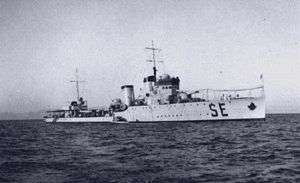Sella-class destroyer
The Sella-class destroyers were a group of four destroyers built for the Regia Marina (Royal Italian Navy) in the 1920s. Two of these ships fought in World War II and both were sunk after the Italian capitulation to the Allies. The two other ships were sold to the Swedish Navy in 1940 and were scrapped in the late 1940s.
 Sella at anchor | |
| Class overview | |
|---|---|
| Builders: | Pattison, Naples |
| Operators: | |
| Built: | 1923–1927 |
| In commission: | 1926–1940s |
| Completed: | 4 |
| Lost: | 2 |
| Scrapped: | 2 |
| General characteristics (as built) | |
| Type: | Destroyer |
| Displacement: | |
| Length: | 84.9 m (278 ft 7 in) |
| Beam: | 8.6 m (28 ft 3 in) |
| Draught: | 2.7 m (8 ft 10 in) |
| Installed power: | |
| Propulsion: | 2 shafts; 2 geared steam turbines |
| Speed: | 33 knots (61 km/h; 38 mph) |
| Range: | 3,600 nmi (6,700 km; 4,100 mi) at 14 knots (26 km/h; 16 mph) |
| Complement: | 152–153 |
| Armament: |
|
These ships formed the basis for most subsequent destroyers built by the Italians, but were disappointing in service with unreliable machinery.
Design and description
The Sella-class destroyers were enlarged and improved versions of the preceding Palestro and Curtatone classs.[1] They had an overall length of 84.9 meters (278 ft 7 in), a beam of 8.6 meters (28 ft 3 in) and a draft of 2.7 meters (8 ft 10 in). They displaced 970 metric tons (950 long tons) at standard load, and 1,480 metric tons (1,460 long tons) at deep load. Their complement was 8–9 officers and 144 enlisted men.[2]
The Sellas were powered by two Parsons geared steam turbines, each driving one propeller shaft using steam supplied by three Yarrow boilers. The turbines were rated at 36,000 shaft horsepower (27,000 kW) for a speed of 33 knots (61 km/h; 38 mph) in service,[1] although the ships reached speeds in excess of 37 knots (69 km/h; 43 mph) during their sea trials while lightly loaded.[3] They carried enough fuel oil to give them a range of 3,600 nautical miles (6,700 km; 4,100 mi) at a speed of 14 knots (26 km/h; 16 mph).[4]
Their main battery consisted of three 120-millimeter (4.7 in) guns in one twin-gun turret aft of the superstructure and one single-gun turret forward of it.[2] Anti-aircraft (AA) defense for the Sella-class ships was provided by a pair of 40-millimeter (1.6 in) AA guns in single mounts amidships and a pair of 13.2-millimeter (0.52 in) machine guns. They were equipped with four 533-millimeter (21 in) torpedo tubes in two twin mounts amidships.[1] The Sellas could also carry 32 mines.[2]
Ships
All four ships were built by the Pattison shipyard in Naples
- Named after Francesco Crispi,
- completed 29 April 1927,
- seized by the Germans after the Italian Armistice in September 1943, served as TA15, sunk by air attack on 8 March 1944 in the Aegean Sea.
- Named after Quintino Sella,
- completed 25 March 1926,
- sunk by German E-boats on 11 September 1943 in the Adriatic Sea.
- Bettino Ricasoli -
- Named after Bettino Ricasoli,
- commissioned 11 December 1926.
- Sold to the Swedish Navy as HSwMS Puke.
- Giovanni Nicotera -
- Named after Giovanni Nicotera,
- commissioned 8 January 1927.
- Sold to the Swedish Navy as the HSwMS Psilander.
Service history
During the war, the destroyers were based at the island of Leros, in the Dodecanese. They took part in the Italian retaking of Kastelorizo (named Operation Abstention by the British) on 27 February 1941, and were used as mother ships for the successful attack by explosive motor boats on HMS York on 25 March. Crispi led the landing of an Italian division on Sitia, Crete, on 28 May 1941, in the course of the battle of Crete.
Notes
- Gardiner & Chesneau, p. 298
- Fraccaroli, p. 43
- McMurtrie, p. 281
- Whitley, p. 159
Bibliography
- Birchfield, B.; Borgenstam, Carl; Caruana, Joseph & Frampton, Viktor (1988). "Question 3/87". Warship International. XXV (2): 205–210. ISSN 0043-0374.
- Brescia, Maurizio (2012). Mussolini's Navy: A Reference Guide to the Regina Marina 1930–45. Annapolis, Maryland: Naval Institute Press. ISBN 978-1-59114-544-8.
- Campbell, John (1985). Naval Weapons of World War Two. Annapolis, Maryland: Naval Institute Press. p. 336. ISBN 0-87021-459-4.
- Chesneau, Roger, ed. (1980). Conway's All The World's Fighting Ships 1922–1946. London: Conway Maritime Press. ISBN 0-85177-146-7.
- Fraccaroli, Aldo (1968). Italian Warships of World War II. Shepperton, UK: Ian Allan. ISBN 0-7110-0002-6.
- Gardiner, Robert & Chumbley, Stephen (1995). Conway's All The World's Fighting Ships 1947–1995. Annapolis, Maryland: Naval Institute Press. ISBN 1-55750-132-7.
- Rohwer, Jürgen (2005). Chronology of the War at Sea 1939–1945: The Naval History of World War Two (Third Revised ed.). Annapolis, Maryland: Naval Institute Press. ISBN 1-59114-119-2.
- Whitley, M. J. (1988). Destroyers of World War 2: An International Encyclopedia. Annapolis, Maryland: Naval Institute Press. ISBN 1-85409-521-8.